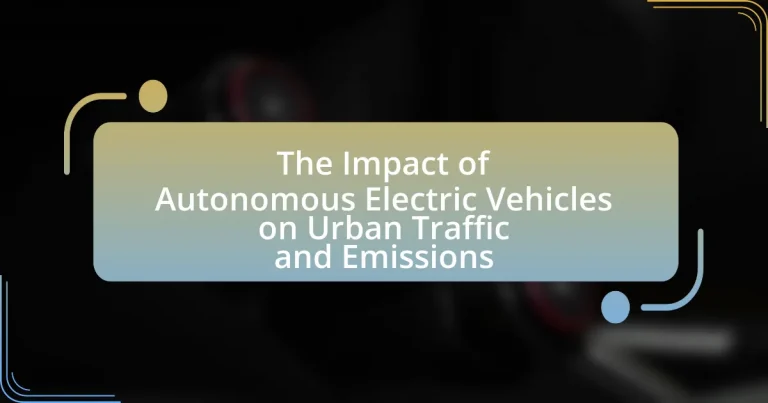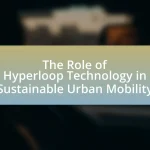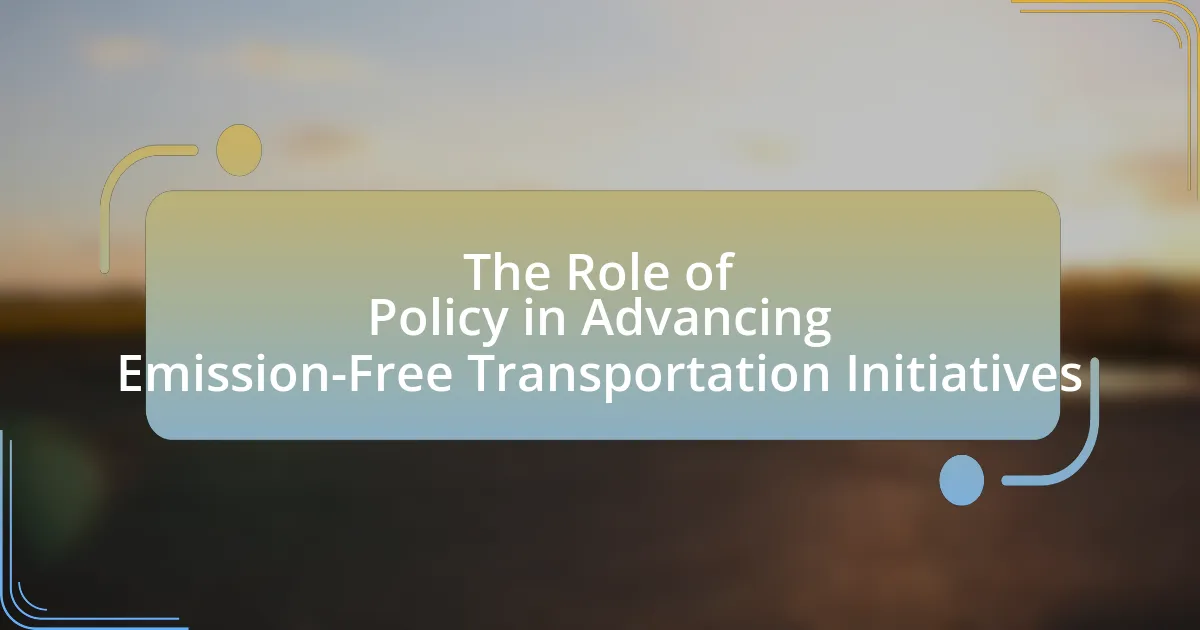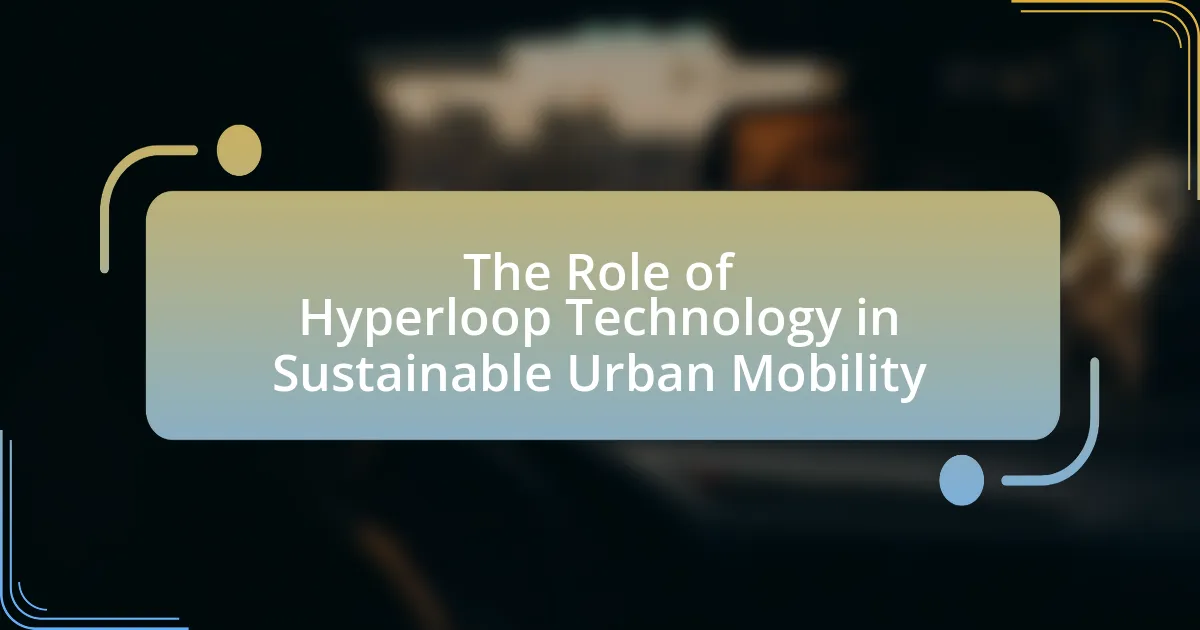Autonomous electric vehicles (AEVs) are self-driving cars powered by electricity, designed to operate without human intervention. They significantly impact urban traffic by reducing congestion, lowering emissions, and enhancing road safety through advanced algorithms and real-time data analysis. AEVs utilize technologies such as sensors and artificial intelligence to navigate complex urban environments, optimizing traffic flow and potentially decreasing travel times by up to 30%. The integration of AEVs into urban transportation systems promises to improve air quality and reduce greenhouse gas emissions, while also addressing challenges related to infrastructure, public perception, and regulatory frameworks necessary for their widespread adoption.
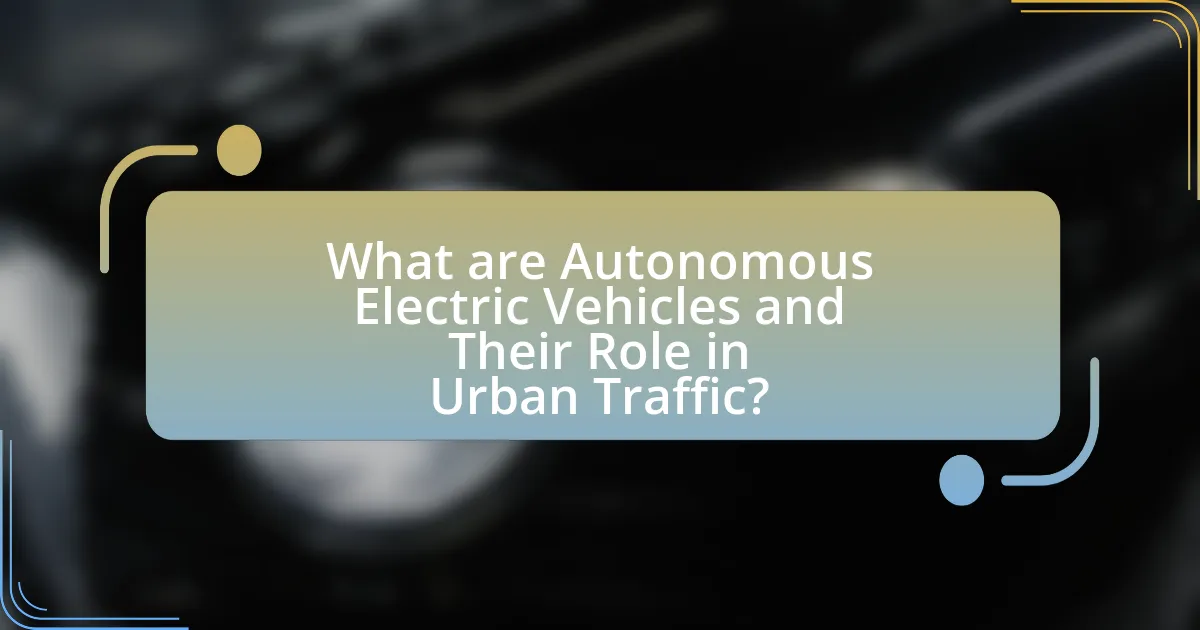
What are Autonomous Electric Vehicles and Their Role in Urban Traffic?
Autonomous electric vehicles (AEVs) are self-driving cars powered by electric energy, designed to navigate and operate without human intervention. AEVs play a significant role in urban traffic by reducing congestion, lowering emissions, and enhancing road safety. Studies indicate that AEVs can optimize traffic flow through advanced algorithms, potentially decreasing travel times by up to 20%. Additionally, as electric vehicles, they contribute to lower greenhouse gas emissions, with estimates suggesting a reduction of up to 70% compared to traditional gasoline vehicles. This dual impact on traffic efficiency and environmental sustainability positions AEVs as a transformative force in urban transportation systems.
How do Autonomous Electric Vehicles operate in urban environments?
Autonomous Electric Vehicles (AEVs) operate in urban environments by utilizing a combination of sensors, artificial intelligence, and electric propulsion systems to navigate and interact with their surroundings. These vehicles are equipped with technologies such as LiDAR, cameras, and radar to detect obstacles, traffic signals, and pedestrians, allowing them to make real-time decisions based on the data collected.
In urban settings, AEVs analyze complex traffic patterns and adapt their driving behavior accordingly, which includes stopping at red lights, yielding to pedestrians, and merging into traffic. The integration of machine learning algorithms enables these vehicles to improve their performance over time by learning from various driving scenarios encountered in the city.
Research indicates that AEVs can significantly reduce traffic congestion and emissions by optimizing routes and minimizing unnecessary stops, as demonstrated in studies conducted by the National Renewable Energy Laboratory, which found that AEVs can reduce urban traffic by up to 30% when deployed in fleets.
What technologies enable the autonomy of electric vehicles?
The technologies that enable the autonomy of electric vehicles include advanced sensors, artificial intelligence, machine learning algorithms, and vehicle-to-everything (V2X) communication systems. Advanced sensors, such as LiDAR, radar, and cameras, provide real-time data about the vehicle’s surroundings, allowing for accurate perception and navigation. Artificial intelligence processes this data to make driving decisions, while machine learning algorithms improve the vehicle’s performance over time by learning from various driving scenarios. V2X communication enhances safety and efficiency by allowing vehicles to communicate with each other and with infrastructure, facilitating coordinated movement and reducing traffic congestion. These technologies collectively contribute to the safe and efficient operation of autonomous electric vehicles in urban environments.
How do electric vehicles differ from traditional vehicles in urban settings?
Electric vehicles (EVs) differ from traditional vehicles in urban settings primarily through their zero tailpipe emissions and reduced noise pollution. EVs contribute to improved air quality in densely populated areas, as they do not emit harmful pollutants like nitrogen oxides and particulate matter, which are prevalent in emissions from gasoline and diesel vehicles. According to a study by the International Council on Clean Transportation, transitioning to electric vehicles can significantly lower urban greenhouse gas emissions, especially when powered by renewable energy sources. Additionally, EVs often feature regenerative braking systems that enhance energy efficiency, further reducing their environmental impact compared to traditional vehicles.
What impact do Autonomous Electric Vehicles have on urban traffic patterns?
Autonomous Electric Vehicles (AEVs) significantly alter urban traffic patterns by improving traffic flow and reducing congestion. AEVs utilize advanced algorithms and real-time data to optimize routing and minimize stop-and-go traffic, which can lead to a 20-30% reduction in travel time according to studies conducted by the Institute of Transportation Engineers. Furthermore, AEVs can communicate with each other and traffic infrastructure, enabling coordinated movements that enhance overall traffic efficiency. This technology also has the potential to decrease the number of vehicles on the road, as shared autonomous services can reduce the need for individual car ownership, thereby lowering vehicle density in urban areas.
How do these vehicles influence traffic congestion?
Autonomous electric vehicles (AEVs) influence traffic congestion by optimizing traffic flow through advanced algorithms and real-time data analysis. These vehicles can communicate with each other and traffic infrastructure, allowing for smoother merging, reduced stop-and-go conditions, and efficient route planning. Studies indicate that AEVs can reduce traffic congestion by up to 30% in urban areas due to their ability to maintain optimal speeds and minimize unnecessary braking. Additionally, AEVs can facilitate carpooling and shared mobility, further decreasing the number of vehicles on the road, which contributes to alleviating congestion.
What changes occur in traffic flow with the introduction of autonomous vehicles?
The introduction of autonomous vehicles leads to smoother traffic flow and reduced congestion. Autonomous vehicles can communicate with each other and traffic infrastructure, allowing for optimized routing and reduced stop-and-go conditions. Studies indicate that traffic flow can improve by up to 30% due to the ability of autonomous vehicles to maintain consistent speeds and reduce the need for sudden braking. Additionally, the integration of autonomous vehicles can decrease the overall number of vehicles on the road, as shared autonomous vehicle services may reduce individual car ownership, further alleviating traffic congestion.
What are the potential benefits of Autonomous Electric Vehicles for urban areas?
Autonomous Electric Vehicles (AEVs) can significantly reduce traffic congestion in urban areas by optimizing traffic flow through advanced algorithms and real-time data analysis. Studies indicate that AEVs can communicate with each other and traffic management systems, leading to smoother traffic patterns and reduced stop-and-go conditions. Additionally, AEVs contribute to lower emissions, as they are powered by electricity and can be programmed to operate efficiently, minimizing energy consumption. Research from the International Council on Clean Transportation shows that widespread adoption of electric vehicles could reduce greenhouse gas emissions by up to 70% in urban settings. Furthermore, AEVs enhance safety by reducing human error, which is responsible for approximately 94% of traffic accidents, according to the National Highway Traffic Safety Administration. Overall, the integration of AEVs in urban environments promises to improve traffic efficiency, decrease pollution, and enhance road safety.
How can these vehicles improve road safety?
Autonomous electric vehicles can improve road safety by utilizing advanced sensors and artificial intelligence to detect and respond to potential hazards more effectively than human drivers. These vehicles are equipped with technologies such as LIDAR, cameras, and radar, which allow them to monitor their surroundings in real-time, reducing the likelihood of accidents caused by human error. According to a study by the Insurance Institute for Highway Safety, autonomous vehicles could potentially reduce traffic fatalities by up to 90% by eliminating common causes of accidents, such as distracted driving and impaired judgment.
What economic advantages do Autonomous Electric Vehicles provide to cities?
Autonomous Electric Vehicles (AEVs) provide significant economic advantages to cities by reducing transportation costs, increasing efficiency, and lowering infrastructure expenses. AEVs can decrease the need for extensive parking facilities, as they can drop off passengers and park themselves in less congested areas, thereby freeing up valuable urban land for development or green spaces. Additionally, studies indicate that AEVs can lower operational costs for public transportation systems by optimizing routes and reducing fuel expenses, as electric vehicles are generally cheaper to operate than traditional gasoline vehicles. Furthermore, the integration of AEVs can lead to decreased traffic congestion, which in turn reduces the economic losses associated with time spent in traffic, estimated at $87 billion annually in the U.S. alone. Overall, the adoption of AEVs can enhance urban economic productivity while promoting sustainable development.
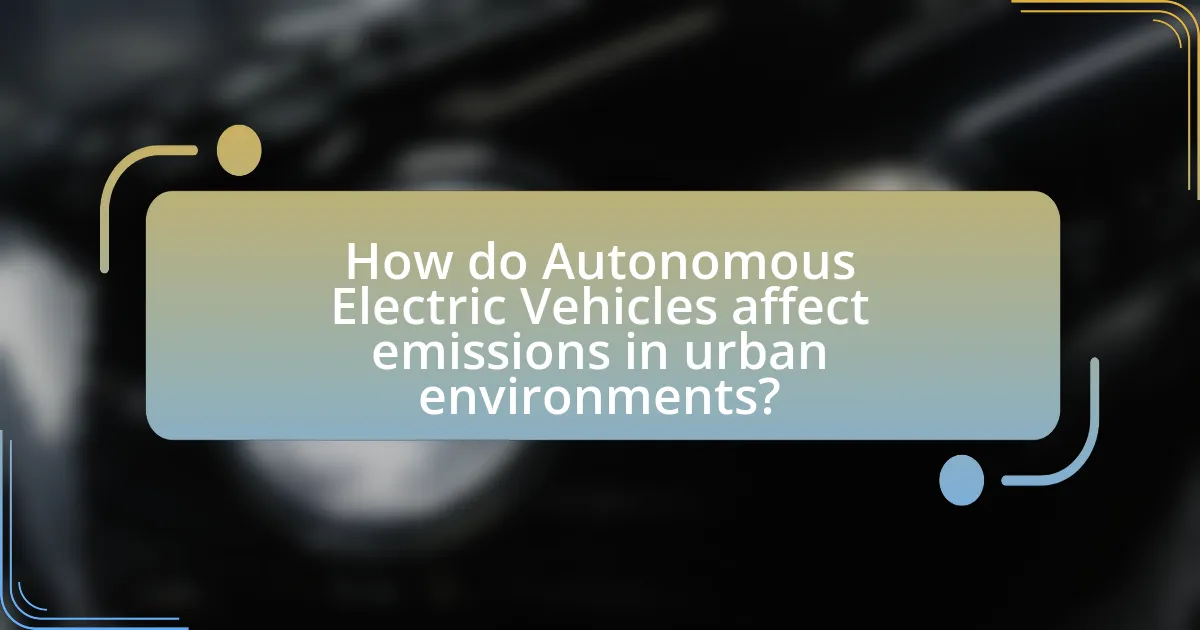
How do Autonomous Electric Vehicles affect emissions in urban environments?
Autonomous Electric Vehicles (AEVs) significantly reduce emissions in urban environments by eliminating tailpipe emissions and optimizing driving patterns. AEVs, powered by electricity, do not produce direct emissions like traditional gasoline or diesel vehicles, contributing to improved air quality. Additionally, studies indicate that AEVs can enhance traffic flow through efficient routing and reduced congestion, which further lowers overall emissions. For instance, research from the International Council on Clean Transportation shows that widespread adoption of electric vehicles, including autonomous models, could reduce greenhouse gas emissions from the transportation sector by up to 80% by 2050. This evidence supports the conclusion that AEVs positively impact urban emissions.
What are the emissions reductions associated with electric vehicles?
Electric vehicles (EVs) significantly reduce emissions compared to traditional internal combustion engine vehicles. Studies indicate that EVs can lower greenhouse gas emissions by up to 70% over their lifetime, depending on the energy source used for electricity generation. For instance, a report by the Union of Concerned Scientists found that, on average, EVs produce less than half the emissions of comparable gasoline-powered vehicles when accounting for the entire lifecycle, including manufacturing and electricity production. This reduction is particularly pronounced in regions where renewable energy sources, such as wind and solar, dominate the electricity grid.
How do emissions from electric vehicles compare to those from gasoline vehicles?
Emissions from electric vehicles (EVs) are significantly lower than those from gasoline vehicles. While gasoline vehicles emit carbon dioxide and other pollutants during operation, EVs produce zero tailpipe emissions. According to the U.S. Environmental Protection Agency, the average gasoline vehicle emits about 404 grams of CO2 per mile, whereas EVs, depending on the source of electricity, can have a much lower carbon footprint, often resulting in emissions equivalent to 100-200 grams of CO2 per mile when accounting for power generation. This stark difference highlights the environmental benefits of EVs in reducing urban air pollution and greenhouse gas emissions.
What role do renewable energy sources play in further reducing emissions?
Renewable energy sources play a crucial role in further reducing emissions by providing cleaner alternatives to fossil fuels for electricity generation and transportation. The transition to renewable energy, such as solar, wind, and hydroelectric power, significantly lowers greenhouse gas emissions, as these sources produce little to no carbon dioxide during operation. For instance, according to the International Renewable Energy Agency (IRENA), the global shift to renewable energy could reduce carbon emissions by up to 70% by 2050. This reduction is essential for mitigating climate change and improving air quality, particularly in urban areas where autonomous electric vehicles are increasingly integrated into the transportation system. By powering these vehicles with renewable energy, cities can achieve substantial emissions reductions, contributing to a more sustainable urban environment.
How do Autonomous Electric Vehicles contribute to sustainable urban development?
Autonomous electric vehicles (AEVs) contribute to sustainable urban development by reducing greenhouse gas emissions and optimizing traffic flow. AEVs operate on electric power, which significantly lowers emissions compared to traditional gasoline vehicles; for instance, the Union of Concerned Scientists reports that electric vehicles produce less than half the emissions of comparable gasoline vehicles over their lifetime. Additionally, AEVs utilize advanced algorithms to enhance traffic management, leading to decreased congestion and improved air quality. Studies indicate that widespread adoption of AEVs could reduce urban traffic by up to 30%, further supporting sustainable urban infrastructure and reducing the need for extensive parking spaces, thereby freeing up land for green spaces and community development.
What urban planning strategies can enhance the benefits of these vehicles?
Integrating dedicated lanes for autonomous electric vehicles (AEVs) can significantly enhance their benefits by improving traffic flow and reducing congestion. These lanes allow AEVs to operate more efficiently, minimizing delays and optimizing travel times. Additionally, implementing smart traffic management systems that prioritize AEVs at intersections can further enhance their operational efficiency, leading to reduced emissions and improved air quality. Research indicates that cities adopting such strategies experience a decrease in overall vehicle emissions by up to 30%, demonstrating the effectiveness of targeted urban planning in maximizing the advantages of AEVs.
How can cities integrate Autonomous Electric Vehicles into public transportation systems?
Cities can integrate Autonomous Electric Vehicles (AEVs) into public transportation systems by developing dedicated infrastructure, implementing regulatory frameworks, and fostering public-private partnerships. Dedicated infrastructure, such as designated lanes and charging stations, ensures efficient operation and accessibility of AEVs. Regulatory frameworks are essential for establishing safety standards and operational guidelines, which can be informed by pilot programs and existing models in cities like San Francisco and Phoenix, where AEVs have been tested successfully. Public-private partnerships can facilitate investment and innovation, as seen in collaborations between companies like Waymo and local transit authorities, enhancing service integration and expanding coverage. These strategies collectively support the seamless incorporation of AEVs into urban transit, ultimately reducing traffic congestion and emissions.
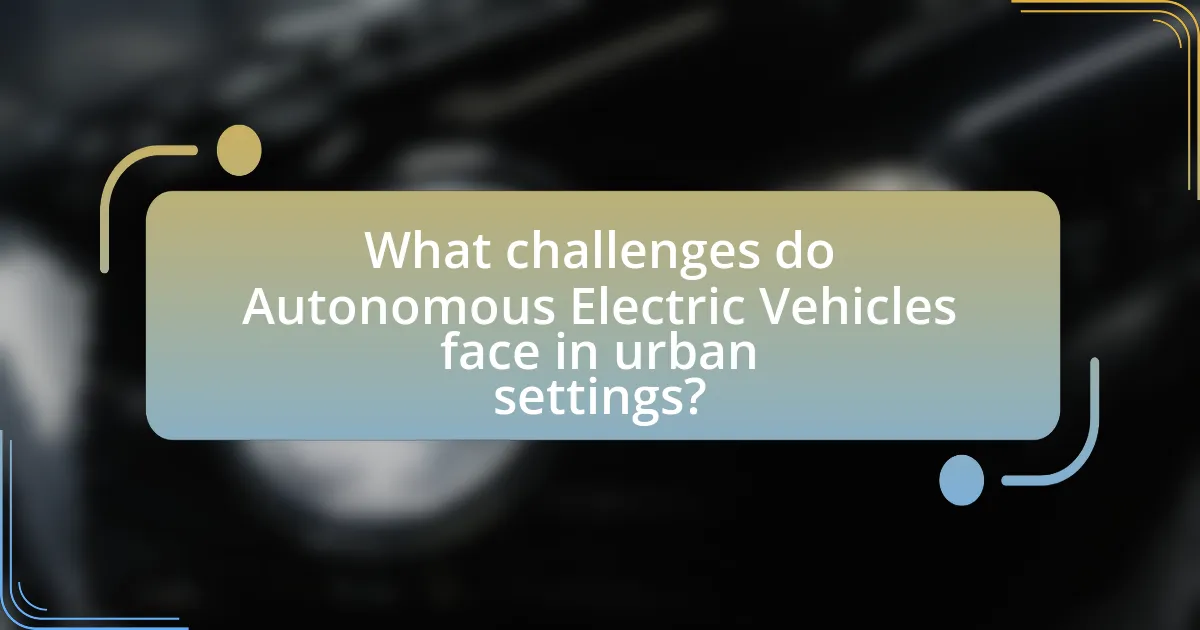
What challenges do Autonomous Electric Vehicles face in urban settings?
Autonomous Electric Vehicles (AEVs) face several challenges in urban settings, including complex traffic environments, unpredictable human behavior, and infrastructure limitations. The complexity of urban traffic involves navigating through dense populations, varied road conditions, and frequent interactions with pedestrians and cyclists, which can lead to difficulties in decision-making for AEVs. Unpredictable human behavior, such as jaywalking or sudden stops, poses additional risks, as AEVs must accurately predict and respond to these actions to ensure safety. Furthermore, inadequate infrastructure, such as insufficient charging stations and poorly maintained roads, can hinder the operational efficiency of AEVs. According to a study by the National Highway Traffic Safety Administration, urban areas account for a significant percentage of traffic incidents, highlighting the need for AEVs to effectively manage these challenges to enhance safety and efficiency in urban environments.
What regulatory hurdles must be overcome for widespread adoption?
Widespread adoption of autonomous electric vehicles (AEVs) requires overcoming regulatory hurdles such as the establishment of safety standards, liability frameworks, and data privacy regulations. Safety standards must be defined to ensure AEVs meet specific performance criteria, which is essential for public trust and acceptance. Liability frameworks need to clarify responsibility in the event of accidents involving AEVs, as traditional insurance models may not adequately address these new technologies. Additionally, data privacy regulations must be developed to protect user information collected by AEVs, as these vehicles rely heavily on data for navigation and operation. The National Highway Traffic Safety Administration (NHTSA) has already begun addressing these issues, indicating the importance of regulatory clarity for the integration of AEVs into existing transportation systems.
How do insurance and liability issues affect the deployment of these vehicles?
Insurance and liability issues significantly impact the deployment of autonomous electric vehicles by creating uncertainty for manufacturers and operators regarding financial responsibility in the event of accidents. This uncertainty can lead to higher insurance premiums, which may deter investment in the technology. For instance, a study by the RAND Corporation indicates that liability frameworks need to evolve to address the unique challenges posed by autonomous vehicles, as traditional models may not adequately cover scenarios involving machine learning and decision-making algorithms. Consequently, the lack of clear liability guidelines can slow the adoption of these vehicles in urban environments, as stakeholders seek to mitigate potential financial risks associated with accidents and malfunctions.
What public perception challenges exist regarding Autonomous Electric Vehicles?
Public perception challenges regarding Autonomous Electric Vehicles (AEVs) include safety concerns, trust in technology, and acceptance of new driving paradigms. Many individuals fear that AEVs may malfunction or be involved in accidents, leading to skepticism about their reliability. A survey by the American Automobile Association in 2021 indicated that 63% of respondents expressed discomfort with the idea of riding in a fully autonomous vehicle, highlighting a significant trust gap. Additionally, the transition from human-driven to autonomous driving raises questions about the loss of control, which can further hinder acceptance. These challenges must be addressed to facilitate the widespread adoption of AEVs and their potential benefits for urban traffic and emissions reduction.
How can cities prepare for the integration of Autonomous Electric Vehicles?
Cities can prepare for the integration of Autonomous Electric Vehicles (AEVs) by developing comprehensive infrastructure plans that include dedicated lanes, charging stations, and smart traffic management systems. These preparations are essential as they facilitate the safe and efficient operation of AEVs, which are projected to reduce urban traffic congestion by up to 30% and lower emissions significantly, according to studies from the International Council on Clean Transportation. Additionally, cities should implement regulatory frameworks that address safety, liability, and data privacy concerns associated with AEVs, ensuring a smooth transition to this new technology.
What infrastructure improvements are necessary to support these vehicles?
Infrastructure improvements necessary to support autonomous electric vehicles include the development of dedicated charging stations, enhanced road signage, and advanced traffic management systems. Dedicated charging stations are essential to accommodate the increased demand for electric vehicle charging, with projections indicating that by 2030, the number of electric vehicles could reach 30 million in the U.S. alone, necessitating a robust charging network. Enhanced road signage is crucial for guiding autonomous vehicles, as these vehicles rely on clear and accurate information to navigate effectively. Advanced traffic management systems, utilizing real-time data and communication technologies, can optimize traffic flow and reduce congestion, which is vital as the integration of autonomous vehicles into urban environments increases. These improvements collectively support the safe and efficient operation of autonomous electric vehicles, ultimately contributing to reduced urban traffic and emissions.
How can public awareness campaigns facilitate acceptance of Autonomous Electric Vehicles?
Public awareness campaigns can facilitate acceptance of Autonomous Electric Vehicles (AEVs) by educating the public about their benefits, addressing safety concerns, and promoting positive perceptions. These campaigns can highlight the environmental advantages of AEVs, such as reduced emissions and improved air quality, which are critical in urban settings where traffic congestion and pollution are prevalent. For instance, studies have shown that informed consumers are more likely to embrace new technologies; a survey by the International Council on Clean Transportation indicated that 70% of respondents were more supportive of AEVs after receiving information about their safety and environmental impact. By effectively communicating these points, public awareness campaigns can build trust and encourage adoption of AEVs among urban populations.
What best practices should cities follow when implementing Autonomous Electric Vehicles?
Cities should prioritize infrastructure development, regulatory frameworks, and public engagement when implementing Autonomous Electric Vehicles (AEVs). Infrastructure development includes creating dedicated lanes and charging stations to accommodate AEVs, which can enhance traffic flow and reduce emissions. Regulatory frameworks should ensure safety standards and liability guidelines specific to AEVs, as seen in California’s regulations that promote innovation while safeguarding public interests. Public engagement is crucial for fostering acceptance and understanding of AEVs, as demonstrated by pilot programs in cities like Phoenix, which have successfully integrated community feedback into their deployment strategies. These best practices collectively contribute to optimizing urban traffic management and minimizing environmental impact.
